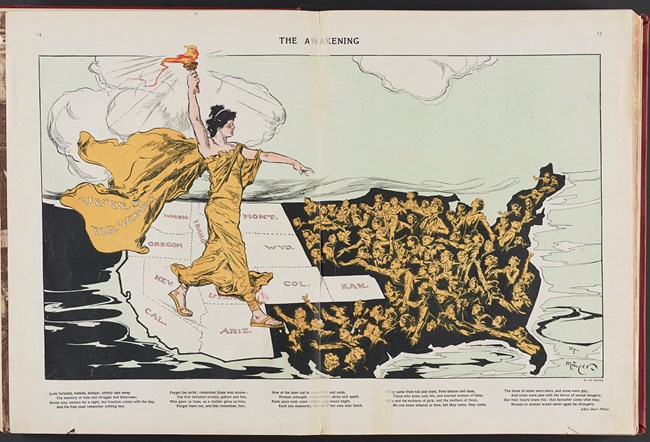
Henry Mayer - New York : Published by Puck Publishing Corporation, 295-309 Lafayette Street, 1915 February 20. Collections of the Library of Congress
The newly minted Alaska Territorial Legislature’s first act was passage of the Shoup Women Suffrage Bill on March 21, 1913. This granting of women’s right to vote in political elections (aka suffrage) had passed with comparative ease. The Seattle Sun newspaper stated its praise for the bill “Alaska is nothing if not progressive,” as quoted in the Skagway, Alaska newspaper The Daily Alaskan 26 June 1913. Alaska’s advocates, however, had not been sitting on their hands, as they had participated in a variety of efforts, being inspired by the national women’s suffrage movement, including the gathering of signatures for petitions then submitted to the Legislature towards the formulation and passage of the bill. Once passed, the bill was quickly signed into law by governor Walter E. Clark and elicited praise by suffragist leaders. The law, however, only applied to women citizens, which at the time, excluded Alaska’s Native people. It would take more legislation and several decades for voting rights “for all” to be more fully realized.
Passage of Alaska’s women’s suffrage bill occurred during a moment in time when much of the country was focused on “progressive” ideas and reform movements of social issues such as civil rights (for some). Several western territories and states from the 1870s into the 1910s had already passed laws granting women the right to vote. Alaska benefitted from this “western” precedent, in addition to efforts of local support, decades of national suffragist activism and the general Progressive mood of the time. It would take, however, seven more years of advocacy and peaceful protest before the 19th amendment to the U.S. Constitution was ratified, on August 18, 1920, to guarantee American women the right to vote.
Learn More
- Take a virtual on-line tour of Alaska’s suffrage history courtesy of the Alaska State Museum’s Alaska’s Suffrage Star: Alaska Women and the Vote in the 1910s and 1920s. https://lam.alaska.gov/suffrage-star
- First Territorial Legislature of Alaska. The first session of the newly established Territory of Alaska Legislature was to grant Alaska women the right to vote, March 21, 1913. Alaska’s Native people, however were denied this right. The road to gaining full citizenship rights, began in 1915, following by several more legislative pieces including the Citizenship Act of 1924 and the Voting Rights Act.
- Women’s History Month in Alaska. March is women’s history month and coincides with Alaska’s anniversary of women’s suffrage. This article includes some Alaska key figures Cornelia Jewett Hatcher and Lena Morrow Lewis, who were advocates for voting and social reform issues.
- The Alaska Native Brotherhood Hall (a National Historic Landmark) in connection with the Sisterhood were instrumental in fighting against racial segregation and for full U.S. citizenship rights, including the right to vote.
- To learn more about Alaska’s remarkable women, including civil rights advocates Elizabeth Peratrovich and Alberta Daisy Schenck Adams whose compelling testimonies contributed to the Territorial Legislature’s passage of Alaska’s Anti-Discrimination Act in 1945, please visit Alaska Women’s Hall of Fame website at: http://alaskawomenshalloffame.org/
Last updated: July 27, 2020
